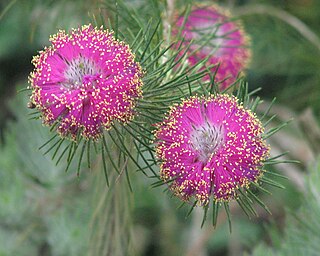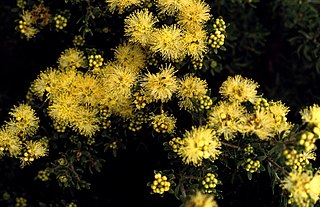
Melaleuca trichophylla is a shrub in the myrtle family, Myrtaceae, endemic to the south-west of Western Australia. Its pink or purple flowers appear from August to December in its native range. It has long been cultivated.

Melaleuca fulgens, commonly known as the scarlet honey myrtle, is a plant in the myrtle family Myrtaceae, and is endemic to Western Australia, South Australia and the Northern Territory. It is notable for its showy orange, red or purple flowers, unusual foliage and fruit, and is a popular garden plant. It is a member of Melaleuca, a large and diverse genus whose members range from large trees such as M. quinquenervia, to small shrubs.

Melaleuca podiocarpa is a plant in the myrtle family, Myrtaceae and is endemic to the south-west of Western Australia. It is a spreading shrub with prickly foliage and small heads of white flowers mostly hidden within the foliage.

Melaleuca sapientes is a plant in the myrtle family, Myrtaceae, endemic to the south-west of Western Australia. It is a small shrub with silky grey leaves and small heads of pinkish flowers in spring or early summer. The attractive, silvery foliage has made this melaleuca a popular garden plant under the incorrect name of Melaleuca holosericea, a similar but much rarer species.
Melaleuca venusta is a shrub in the myrtle family Myrtaceae and is endemic to the west coast of Western Australia. It is a shrub with silvery leaves and heads of pink to purple flowers which fade to white and with a restricted distribution, north of the Murchison River district.

Melaleuca undulata, commonly known as hidden honey-myrtle is a shrub in the myrtle family Myrtaceae and is endemic to the south of Western Australia. It is a spreading, moderately dense, perennial, woody shrub with creamy-white flowers in small clusters.
Melaleuca lecanantha is a plant in the myrtle family, Myrtaceae and is endemic to a small area of south-west Western Australia. It is a shrub with small, rather fleshy leaves and pink to lilac-coloured flowers in early spring. The plant was first described in 1867 but the name given to it was considered illegitimate and it was not until 1998 that it was first formally described.

Melaleuca leiocarpa, commonly known as pungent honey-myrtle, is a plant in the myrtle family, Myrtaceae and is native to arid areas in parts of South Australia and Western Australia. It is an erect or branching shrub distinguished by its prickly foliage, yellowish flowers and, for a melaleuca, unusually large, smooth, roughly spherical fruits.

Melaleuca leiopyxis is a shrub in the myrtle family, Myrtaceae and is endemic to an area near the west coast of Western Australia. It has bright yellow flowers and is very similar to Melaleuca depressa. The ranges of the two species overlap making it difficult to distinguish between them.

Melaleuca dichroma is a shrub in the myrtle family, Myrtaceae and is endemic to the south-west of Western Australia. It is unusual for its genus in that its flowers are yellow or creamy-white but age to a pinkish-red.

Melaleuca incana subsp. tenella is a plant in the myrtle family Myrtaceae which is endemic to the south coast of Western Australia. It was formerly known as Melaleuca tenella Benth. but was reduced to a subspecies in 1998. It is similar to M. incana subsp. incana except in the form of the plant, the size and shape of its leaves, its flowering time and distribution.

Melaleuca acutifolia is a plant in the myrtle family, Myrtaceae and is endemic to the south-west of Western Australia. It has small, pointed, oval leaves and in summer, heads of white flowers. The species was originally described as a variety of Melaleuca lateriflora but was raised to species status in 2010.

Melaleuca lateriflora, commonly known as gorada, is a plant in the myrtle family, Myrtaceae and is endemic to the south-west of Western Australia. It is usually an erect shrub with oval leaves and small clusters of white flowers mainly along the older branches.
Melaleuca linophylla is a plant in the myrtle family Myrtaceae and is native to the north-west of Western Australia. It is a bushy shrub with narrow leaves and spikes of cream-coloured flowers in spring. It is distinguished by its fruits which are much more urn-shaped than those of other melaleucas.
Melaleuca oldfieldii is a plant in the myrtle family, Myrtaceae, and is native to the south-west of Western Australia. It is distinguished by its bright yellow flower heads but its distribution is restricted to one national park.

Melaleuca plumea is a shrub in the myrtle family, Myrtaceae, and is endemic to the south of Western Australia. It is a widely spreading, densely foliaged shrub which produces masses of deep pink flowers in spring and early summer. Fluffy hairs on parts of the flowers, including the bracts covering the flower buds, are also a feature.
Melaleuca polycephala is a shrub in the myrtle family, Myrtaceae, and is endemic to the south-west of Western Australia. It is a sparsely foliaged, twiggy shrub with deep purple flowers in spring.

Melaleuca psammophila is a plant in the myrtle family, Myrtaceae, and is endemic to the south-west of Western Australia. It is a small shrub with narrow leaves, heads of purple, pink or mauve flowers and clusters of woody fruit. It is similar to M. bisulcata but differs from that species in characters such as the shape of its fruit, leaves and buds but like that species is an attractive, profusely flowering shrub suitable for cultivation as a garden plant.

Melaleuca spicigera is a plant in the myrtle family, Myrtaceae, and is endemic to the south-west of Western Australia. It has wavy, stem-clasping, blue-green leaves and spikes of pink flowers in spring.

Melaleuca thymoides is a plant in the myrtle family, Myrtaceae, and is endemic to the south-west of Western Australia. It is usually a low shrub. The ends of the branches usually end in a sharp spine and the leaves also have a sharp point. Bright yellow flowers appear on the ends of the branches in spring or early summer.

















